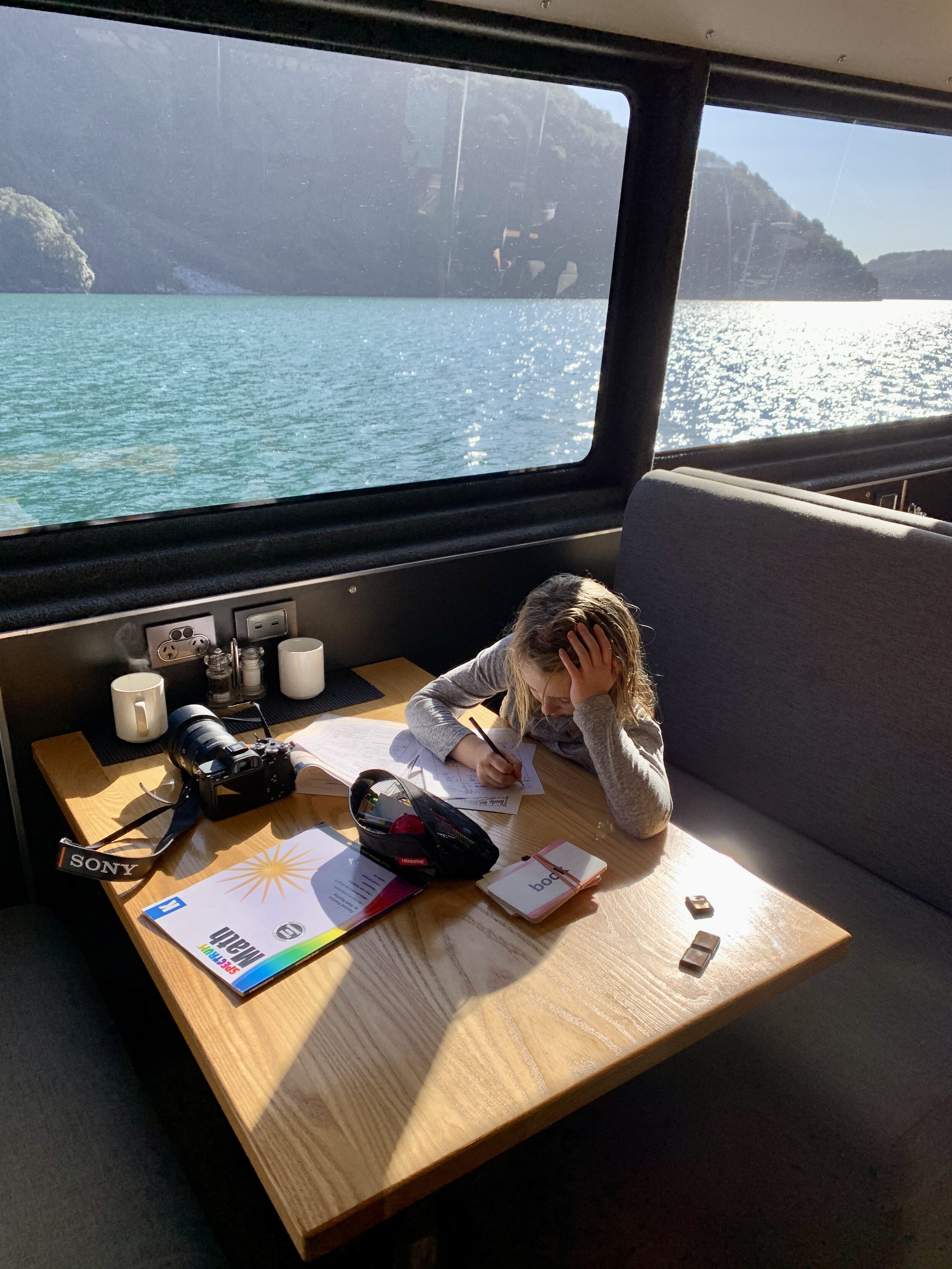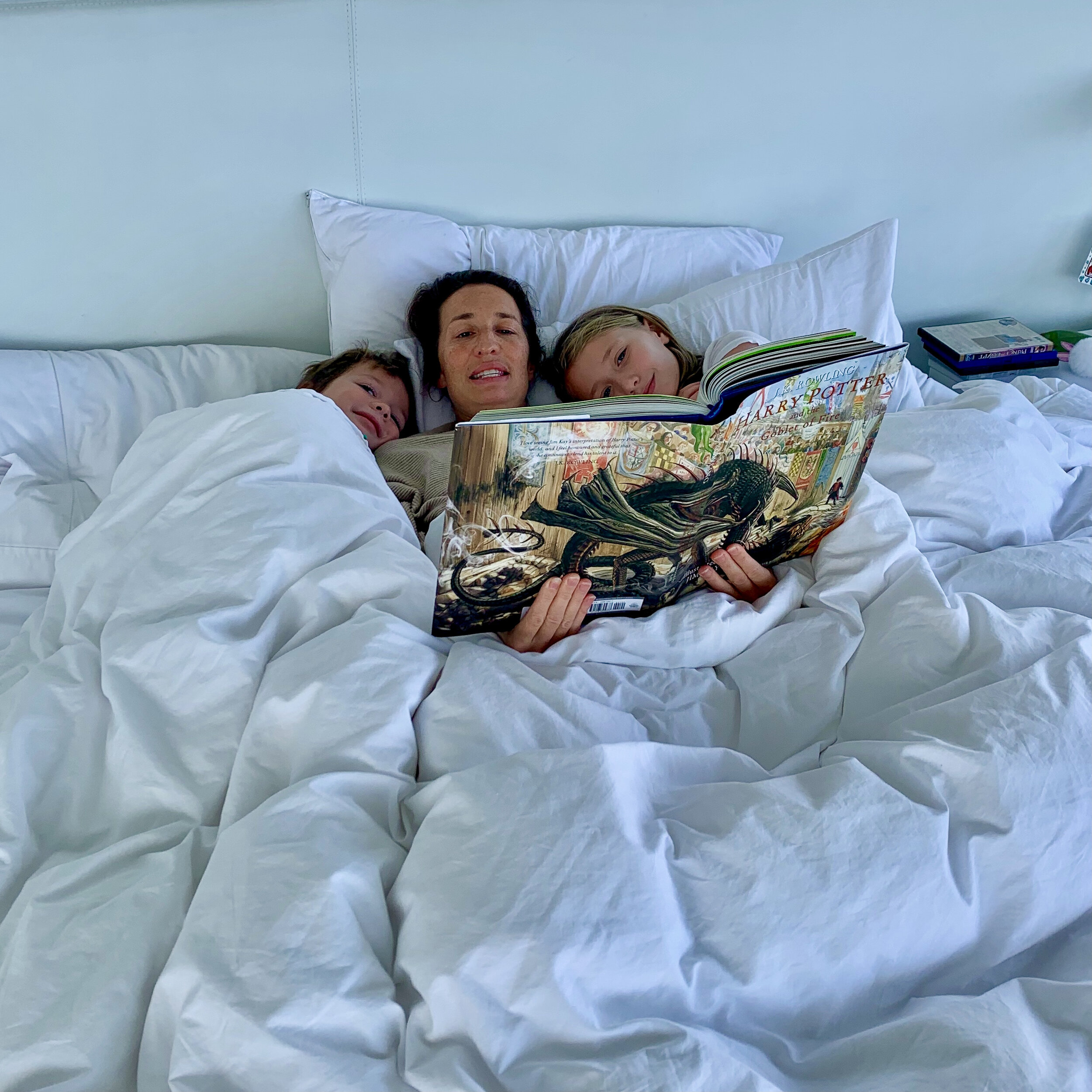Homeschool Around the World (Day 282)
As I reflect on our homeschool journey, I am enormously proud of what we accomplished.
Most every day was a combination of “normal homeschool” and an immersive field trip that was hands on, fun, and at a kid’s pace.
The children:
Made their own Greek mosaics,
Played Rwandan dodgeball,
Watched a goat sacrifice,
Had breakfast with hippos,
Ate chakalaka,
Explored caves with skeletons of extinct giant lemurs,
Went on a “bug safari,”
Explored Arab markets,
Learned about Aboriginal plant medicine,
Made wooden umbrellas,
Made paper out of elephant poo,
Gave offerings to Buddhist monks,
Swam with mantas,
Searched for nocturnal kiwis,
And so much more!
*****
We ended up doing school work in some pretty unusual places.
On a boat in Milford Sound, NZ.
On the Mekong River, Laos.
In the Mykonos airport.
In an airplane over Myanmar.
Next to a blue domed church in Santorini.
*****
Did homeschool turn out exactly as we planned? NO! I put a lot of time into planning our homeschool curriculum, and fully 25% of our bags were homeschool items. We planned homeschool to be focused on literacy and math. We felt like we would learn about science, social studies, art, PE, etc. just from the daily activities of the trip.
For unknown reasons, the kids decided to call me “Mrs. Butterball” when I was their teacher. Mrs. Butterball learned so much about perseverance, changing plans on the fly – and a whole new level of respect for great teachers!!
The key for us was consistency and doing schoolwork 6 days a week no matter what. We learned to work with things that were just in front of us. Hugh liked counting plates at our AirBNB.
It was sort of hard to stay focused when the choice is, “work on writing, or go to the amazing beach right in front of you.”
*****
We loved to see how Hugh and Hazel would incorporate what they learned into their games and activities. One day, Hugh proudly showed us his Lego Burj Khalifa, the world’s tallest building (which we visited in Dubai).
In Indonesia, Hazel used her math skills to think about the local currency, the Rupiah (which is among the weakest currencies in the world). One US dollar is equivalent to about 14,000 Rupiah. This results in some wild sounding prices… Dinner for 4 at the Jakarta airport restaurant was about 280,000 Rupiah. But 280,000 US dollars will buy you an average house in the USA.
And if you have about 70 US dollars, you are a millionaire in Rupiah!
The kids did a few written projects based on what they learned in different countries. Hazel wrote 3 blog posts and 2 books. Hugh wrote a blog post on koalas.
Hazel taking notes for her elephant book in Thailand.
The finished product - Incredible Elephants by Hazel A. Harmon.
*****
We rarely came across bookstores at all, let alone ones with books in English. So, when we did find a bookstore with books the kids could read, they felt like it was Christmas!
We found some terrific new authors along the way. Check out David Williams, a British author who is a modern-day Roald Dahl. Some of our favorites include The Midnight Gang and Demon Dentist.
After we read our books, we left them behind for a local family. You can’t carry much extra on a 300-day trip…
*****
On our extended stays in Australia and New Zealand, we managed to find terrific local tutors who could meet with the kids a few times a week. Bringing in these professionals was a wonderful break for me, and also a good opportunity to have a skilled person help kids through challenging areas.
*****
While the kids did a good job with the normal curriculum, they did a great job learning about the 3 focus subjects of our trip:
The amazing diversity of world cultures
History in every country, and
Animals, animals, animals!
We had so many memorable field trips – nearly every day, really. In Myanmar alone, we:
operated a forge with our feet,
made paper from mulberry bark
helped create bronze statues,
made wooden umbrellas
explored ancient temples by flashlight
learned how to make wooden boats, woven cloth, and more
learned to cook Burmese food, and
ground peanuts into peanut oil using buffalo power
*****
We learned so much about the incredible diversity of the world.
In Mayanmar, we met Kayan women who wear big necklaces that stretch out their necks.
We also wore Longyis, traditional Burmese outfits that are worn everyday by men and women alike. It is disrespectful to enter a temple in shorts, so we also wore our longyis most every day.
We rode trishaw bikes in Southeast Asia.
We planted trees and crops, spent a week living with elephants, and picked tea leaves… And through it all we kept on track with our home school.
*****
PE class was an adventure.
The kids took some lessons in Muay Thai (Thai kickboxing)!
But the big surprise win was indoor skydiving! We first tried it in Dubai, and Hazel was hooked. It involves going into a huge vertical tube with air blowing at 120 mph. An instructor helps you learn to float and maneuver yourself by moving your body to catch the wind. Hazel learned to fly all around the tube on her own and also to fly on her back.
We also found indoor skydiving in Australia and in New Zealand. By chance, our Queenstown AirBnB was a five-minute walk from the indoor skydiving location!
After watching several times, Hugh joined in. Hugh flew to the top of the tube on his first flight!
In fact, they loved it so much that we even requested a STEM class. The instructor taught the kids about how the tunnel works, and we played fun games, like pouring water into the tunnel to watch the water float in the air!
*****
Jamie and I wanted the kids to really think about and compare the different countries we visited. Obviously, we were going to focus on what made each country unique (lemurs in Madagascar). But we also wanted the kids to be able to see the same thing over and over across countries to see the differences.
This led to our comparative field trip curriculum. In each country, we visited a grocery store, a local house and a school. We also did at least one cooking class. When it seemed appropriate, we attended a religious service.
Two different schools we saw in Laos.
We also wanted them to learn some simple phrases to greet and thank people in their native language. How is your Kinyarwanda or Malagasy? (The main languages of Rwanda and Madagascar.) In some countries, there are so many languages that we needed to learn 3 or 4 ways just to say hello.
Probably the biggest success was visiting the schools. It worked on so many levels. Our kids always enjoyed seeing local kids. They loved playing with kids at recess and teaching each other hand clapping games (like “Mrs. Mary Mack”).
Several times, local kids would show us their English skills by singing ABC or Old Macdonald. Their foreign language skills put ours to shame!
*****
When COVID hit, our world became very small. We were locked down in New Zealand, which was super serious about the virus, so we couldn’t leave our house/ yard for about 5 weeks. (No takeout food. No Amazon deliveries. And someone else had to get our groceries.) With no field trips, we had way more time for “normal homeschool.”
And more time for at home creativity! Hazel and Hugh made super involved rock and shell creations. Hugh also spent hours every day playing a game with sticks that he called “Quick Spiders.” To us, it looked like he was just throwing sticks around, but he loved it!
The kids also made lava lamps with ingredients from the grocery store. LOTS of lava lamps….
Somedays, we decided to spend the day in bed reading Harry Potter, and we worked our way through 2 of the books.
When our friends in the US went into lockdown, I became a bit of a homeschool consultant. My friends suddenly had to start remote learning/ homeschooling, and we had been doing it all year. The main advice was to try to do some work every day, to cherish the time, and to look for activities that resonate with the kids. You never know what will motivate them. Hugh was not always excited about writing, but he wanted to send a letter to President Trump.
“Dear President Trump,
New Zealand is doing total lockdown. I think you should do it too. Do you agree? I don’t want people to get sick.
From,
Hugh Harmon, Age 5”
*****
We came back to the States in June and continued with our homeschooling right up till the day before school started in September. (Mrs. Butterball is such a task master!) Hazel and Hugh were thrilled to return to school, with real teachers and friends. Although they had some nerves, both of them literally ran into 1st and 3rd grade.
On the days they are home doing remote school here in America, I occasionally hear a reference to our trip. The first graders were talking about needs and wants, and Hugh told his class about the village in Northern Kenya where the whole community shared one notebook. Another time, I came across a draft of a nonfiction story Hazel was writing. It was about a day in Madagascar where we all went snorkeling, and she felt like a mermaid. In her mind, it had been the perfect day.
When we left on the trip, we told the kids that it would change us all in profound ways, but we didn’t yet know what those ways would be. From our yearlong experiment teaching our kids, I feel like I understand them as learners in a way I might never have. I continue to be in total awe of teachers and the role they play in helping to develop inquisitive minds. And the intense amount of work which is required!
Our kids came back academically ready for the next year, with a little catch up work needed in some areas. More importantly, they had grown in ways that we hope will make them better human beings: compassionate, tolerant, kind, aware and accepting of differences, intellectually curious, resilient…
And, thanks to Mrs. Butterball, VERY APPRECIATIVE of their real teachers at school!

































